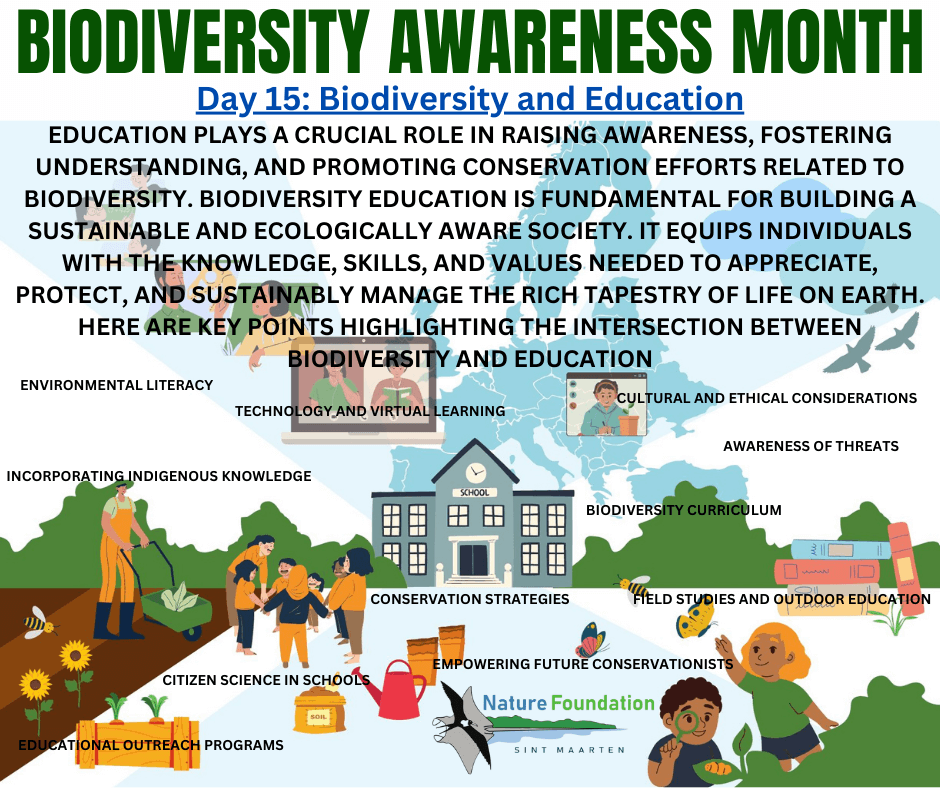Biodiversity month day 15: Biodiversity and Education
Education plays a crucial role in raising awareness, fostering understanding, and promoting conservation efforts related to biodiversity.
The St. Maarten Hospitality & Trade Association supports the March Biodiversity awareness month organized by the Nature Foundation in an effort to help protect St. Maartens nature and biodiversity. Todays topic: Biodiversity and Education
Here are key points highlighting the intersection between biodiversity and education:
1. Environmental Literacy: Education is essential for building environmental literacy, which includes an understanding of biodiversity, ecosystems, and the interconnections between species. An environmentally literate population is better equipped to make informed decisions about the environment and contribute to conservation efforts.
2. Biodiversity Curriculum: Integrating biodiversity into educational curricula at various levels, from primary schools to higher education, helps ensure that students develop a foundational understanding of the importance of biodiversity, the threats it faces, and the ways to conserve it.
3. Field Studies and Outdoor Education: Field studies and outdoor education experiences provide students with hands-on opportunities to explore natural habitats, observe biodiversity, and engage in ecological studies. These experiences enhance learning and foster a connection to the natural world.
4. Citizen Science in Schools: Involving students in citizen science projects allows them to actively participate in scientific research related to biodiversity. Students can contribute to data collection, monitor local ecosystems, and engage in meaningful, real-world science.
5. Awareness of Threats: Education helps individuals understand the various threats to biodiversity, including habitat loss, pollution, climate change, and over-exploitation of natural resources. This awareness is crucial for developing a sense of responsibility and motivating action.
6. Cultural and Ethical Considerations: Education can highlight the cultural and ethical dimensions of biodiversity conservation. Students can learn about the cultural importance of certain species to communities and the ethical considerations associated with the stewardship of biodiversity.
7. Conservation Strategies: Understanding biodiversity goes hand in hand with learning about conservation strategies. Education equips individuals with the knowledge of sustainable practices, habitat restoration, and wildlife conservation efforts, empowering them to contribute to positive change.
8. Technology and Virtual Learning: Technology, including virtual reality, online platforms, and interactive resources, can enhance biodiversity education by providing immersive experiences, virtual field trips, and access to global data sets. These tools make learning about biodiversity more accessible and engaging.
9. Educational Outreach Programs: Educational outreach programs, organized by environmental organizations, NGOs, and government agencies, play a vital role in bringing biodiversity education to communities. Workshops, seminars, and outreach initiatives help disseminate information and build local capacity for conservation.
10. Empowering Future Conservationists: Education nurtures the next generation of environmental stewards and conservationists. By instilling a sense of responsibility and fostering a love for nature, education empowers individuals to actively contribute to biodiversity conservation efforts throughout their lives.
11. Incorporating Indigenous Knowledge: Biodiversity education should recognize and incorporate indigenous knowledge and traditional ecological wisdom. This inclusion promotes a more holistic understanding of ecosystems and biodiversity, acknowledging the valuable insights of local communities.
In conclusion, biodiversity education is fundamental for building a sustainable and ecologically aware society. It equips individuals with the knowledge, skills, and values needed to appreciate, protect, and sustainably manage the rich tapestry of life on Earth.
Back to the Visit St Maarten Main page

